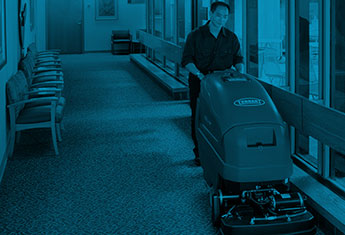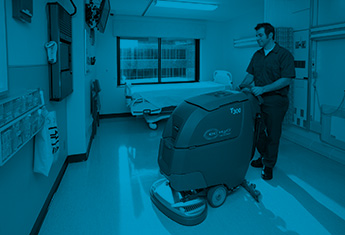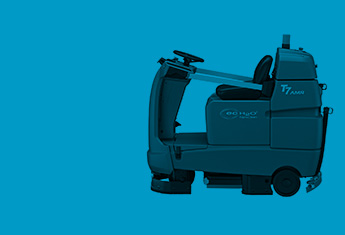Your shopping cart is empty.
Floor Cleaning Tips for a Post-COVID Hospital Environment
Posted in Best Practices, Industry News & Trends,
COVID may be here to stay, but the way that organizations — especially healthcare facilities — are coping with the endemic has shifted significantly over the past year. Hospitals and clinics are now struggling to strike a balance between ongoing infection prevention and sustainable healthcare cleaning costs.
The virus that causes COVID-19 can be picked up from surfaces, but according to the CDC, the risk of disease transmission is far greater from airborne particulates. For this reason, healthcare floor cleaning may slip down your organization’s priority list as it copes with fewer resources and staff. However, that can be a short-sided view when thinking about your post-COVID hospital cleaning and disinfection strategy.

Establishing Sustainable Cleaning Practices
In the early days of the pandemic, you couldn’t grab a shopping cart without a masked employee first wiping it down for you. Every type of facility, from grocery stores to medical offices, constantly smelled like hand sanitizer — that is, if they weren’t closed entirely.
Now that hospitals, clinics, and healthcare systems enter this new reality, stakeholders must carefully consider which floor cleaning practices enhance the health and safety of their facility and not just sanitation theater.
This should be done with careful consideration, as many of the cleaning practices established during the height of the pandemic have been shown to improve hospital-acquired infection (HAI) rates. This is an important part of calculating the true costs of cleaning efforts since Medicare doesn’t reimburse hospitals for treatment costs associated with HAIs.
Autonomous floor cleaners from Tennant Company can help your hospital derive the most value from a limited janitorial labor force so that human effort can be redeployed toward high-touch areas that have a significant impact on infection prevention and control.
Cleaning the Rooms of COVID-19 Patients
The CDC has specific guidance for infection control and prevention practices for COVID-19 patients—whether they’re being treated in an intensive care unit or a general unit. Some key points include:
- Patients must be in a single-occupancy room
- The room must have its own bathroom
- Hospitals should limit moving patients outside their rooms unless it’s medically necessary to do so
- Individuals visiting a COVID-19 patient should limit their time in the rest of the facility
These protocols may cease when a patient tests negative for COVID-19 or ten days have passed since their symptoms first appear.
Hospitals may want to take specialized floor-cleaning precautions as dedicated COVID-19 units are sunset and transitioned back to general use. Micro-Scrubbers can help staff clean floors better and more efficiently, and with brush widths as narrow as 11 inches, they’re adept at navigating single-occupancy patient rooms. This transition isn’t just a prime opportunity for a deeper clean as rooms are largely empty and equipment is reshuffled around the hospital; it also sends a powerful message to future patients about the hospital’s commitment to infection control.

Best Practices for Cleaning the Entire Hospital
Think Outside of the Patient Room
Your concerted cleaning efforts shouldn’t neglect staff breakrooms and on-call rooms. Nurses, doctors, and other clinicians spend significant amounts of time in these spaces — potentially without PPE as they eat, drink, and sleep. Keeping staff healthy (and units properly staffed) is a vital part of patient safety.
Optimize Labor
Use robotics to work alongside environmental services employees. Robotics can improve employee productivity and reduce the impact of staffing constraints by providing reliable cleaning every day.
Keep Water Off the Floors
Reduce the risk of slip and fall accidents by using NSFI-certified cleaning equipment that removes dirt and soil, maintains air quality, and leaves surfaces safe and dry.
Limit Machine Noise
Use machines that are quiet and allow for daytime cleaning. The noise outside a patient’s room can impact their stay and potentially reduce HCAHP scores.
Choose Floor Types Wisely
Seamless, sealed, and impervious flooring are the best choices for mitigating bacteria growth. Conversely, surfaces with grout or that are porous in nature are not recommended. Some disinfectants and cleaning chemicals can erode flooring surfaces or create slip-and-fall risks.

Your hospital should balance the longevity of flooring surfaces and other risks with a desire to ensure your hospital doesn’t just look clean but is clean, too. Learn more about floor cleaning technology from Tennant Company that can help keep patients safe.
RELATED LINKS
Ready to take your cleaning to the next level?
Whether you are requesting a product demonstration or a quote, ordering parts, or making a service appointment, you've come to the right place. Tennant professional representatives are ready with answers to your questions, and we look forward to showing you how much we appreciate your business.




